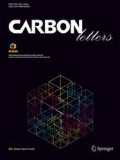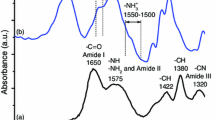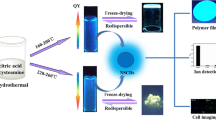Abstract
A new discrete bis-dithiolene complex, [PPh4]2[Zn(DMED)2] (1; DMED = 1,2-dicarbomethoxy-1,2-dithiolate) with sulfur-based radical character was synthesized and structurally characterized. Complex 1 is stable and exhibits a square planar geometry around the zinc metal. 1 forms nanospheres through a one-pot water-induced self-assembly in a mixture of solvents (acetonitrile–water). These nanospheres were further decorated with water-soluble carbon nanotubes (wsCNTs) through hydrogen bonding between the peripheral –COOCH3 groups of 1 and surfacial carboxyl groups of wsCNTs to assemble into a spherical nanocomposite. The as-prepared nanocomposite showed fluorescence emissions in visible region due to the separation of energy states of the nanospheres assisted by wsCNTs, suggesting the future possibilities of these new materials for use in biomedical application.








Similar content being viewed by others
Change history
11 April 2023
A Correction to this paper has been published: https://doi.org/10.1007/s42823-023-00501-7
References
Schönherr H, Paraschiv V, Zapotoczny S, Crego-Calama M, Timmerman P, Frank CW, Vancso GJ, Reinhoudt DN (2002) Unraveling the nanostructure of supramolecular assemblies of hydrogen-bonded rosettes on graphite: an atomic force microscopy study. Proc Natl Acad Sci USA 99:5024–5027
Okesola BO, Mata A (2018) Multicomponent self-assembly as a tool to harness new properties from peptides and proteins in material design. Chem Soc Rev 47:3721–3736
Tocchio A, Durmus NG, Sridhar K, Mani V, Coskun B, El Assal R, Demirci U (2018) Magnetically guided self-assembly and coding of 3D living architectures. Adv Mater 30:1705034
Liu K, Xing R, Zou Q, Ma G, Möhwald H, Yan X (2016) Simple peptide-tuned self-assembly of photosensitizers towards anticancer photodynamic therapy. Angew Chem 128:3088–3091
Zhou L, Tan Y, Wang J, Xu W, Yuan Y, Cai W, Zhu S, Zhu J (2016) 3D self-assembly of aluminium nanoparticles for plasmon-enhanced solar desalination. Nat Photon 10:393
Aliprandi A, Mauro M, De Cola L (2015) Controlling and imaging biomimetic self-assembly. Nat Chem 8:10
Ozin GA, Hou K, Lotsch BV, Cademartiri L, Puzzo DP, Scotognella F, Ghadimi A, Thomson J (2009) Nanofabrication by self-assembly. Mater Today 12:12–23
Sathyajith R, Andavan GTS, Cengiz O (2006) Selective and controlled self-assembly of zinc oxide hollow spheres on bundles of single-walled carbon nanotube templates. Nanotechnology 17:723
Wang ZL (2004) Zinc oxide nanostructures: growth, properties and applications. J Phys Condens Matter 16:R829–R858
Pearton SJ, Norton DP, Ip K, Heo YW, Steiner T (2004) Recent advances in processing of ZnO. J Vac Sci Technol, B 22:932–948
Park SJ, Das GS, Schütt F, Adelung R, Mishra YK, Tripathi KM, Kim T (2019) Visible-light photocatalysis by carbon-nano-onion-functionalized ZnO tetrapods: degradation of 2,4-dinitrophenol and a plant-model-based ecological assessment. NPG Asia Mater 11:8
Sandanayaka ASD, Araki Y, Wada T, Hasobe T (2008) Structural and photophysical properties of self-assembled porphyrin nanoassemblies organized by ethylene glycol derivatives. J Phys Chem C 112:19209–19216
Wahab MA, Sudhakar S, Yeo E, Sellinger A (2008) Evaporation-induced self-assembly of mesoscopically ordered organic/organosilica nanocomposite thin films with photoluminescent properties and improved hardness. Chem Mater 20:1855–1861
Sun S (2006) Recent advances in chemical synthesis, self-assembly, and applications of FePt nanoparticles. Adv Mater 18:393–403
Zhang X, Pint CL, Lee MH, Schubert BE, Jamshidi A, Takei K, Ko H, Gillies A, Bardhan R, Urban JJ, Wu M, Fearing R, Javey A (2011) Optically- and thermally-responsive programmable materials based on carbon nanotube-hydrogel polymer composites. Nano Lett 11:3239–3244
Tripathi KM, Vincent F, Castro M, Feller JF (2016) Flax fibers—epoxy with embedded nanocomposite sensors to design lightweight smart bio-composites. Nanocomposites 2:125–134
Frackowiak E, Khomenko V, Jurewicz K, Lota K, Béguin F (2006) Supercapacitors based on conducting polymers/nanotubes composites. J Power Sour 153:413–418
Kim T, Mo YH, Nahm KS, Oh SM (2006) Carbon nanotubes (CNTs) as a buffer layer in silicon/CNTs composite electrodes for lithium secondary batteries. J Power Sour 162:1275–1281
Yan Y, Ge X, Liu Z, Wang J-Y, Lee J-M, Wang X (2013) Facile synthesis of low crystalline MoS2 nanosheet-coated CNTs for enhanced hydrogen evolution reaction. Nanoscale 5:7768–7771
Banerjee S, Wong SS (2002) Synthesis and characterization of carbon nanotube − nanocrystal heterostructures. Nano Lett 2:195–200
Haremza JM, Hahn MA, Krauss TD, Chen S, Calcines J (2002) Attachment of single CdSe nanocrystals to individual single-walled carbon nanotubes. Nano Lett 2:1253–1258
Chan WCW, Nie S (1998) Quantum dot bioconjugates for ultrasensitive nonisotopic detection. Science 281:2016–2018
Zhang P, Huang H, Huang J, Chen H, Wang J, Qiu K, Zhao D, Ji L, Chao H (2015) Noncovalent ruthenium(II) complexes–single-walled carbon nanotube composites for bimodal photothermal and photodynamic therapy with near-infrared irradiation. ACS Appl Mater Interfaces 7:23278–23290
Akhavan O, Azimirad R, Safa S, Larijani MM (2010) Visible light photo-induced antibacterial activity of CNT–doped TiO2 thin films with various CNT contents. J Mater Chem 20:7386–7392
Ke D, Tianyou P, Dingning K, Bingqing W (2009) Photocatalytic hydrogen generation using a nanocomposite of multi-walled carbon nanotubes and TiO2 nanoparticles under visible light irradiation. Nanotechnology 20:125603
Mrkvová K, Kameníček J, Šindelář Z, Kvítek L, Mrozinski J, Nahorska M, Žák Z (2004) Synthesis, properties and crystal structures of R[MIII(bdt)2] complexes (M = Ni Co, Cu). Transit Met Chem 29:238–244
Tehfe M-A, Dumur F, Telitel S, Gigmes D, Contal E, Bertin D, Morlet-Savary F, Graff B, Fouassier J-P, Lalevée J (2013) Zinc-based metal complexes as new photocatalysts in polymerization initiating systems. Eur Polym J 49:1040–1049
Tripathi KM, Begum A, Sonkar SK, Sarkar S (2013) Nanospheres of copper(iii) 1,2-dicarbomethoxy-1,2-dithiolate and its composite with water soluble carbon nanotubes. New J Chem 37:2708–2715
Begum A, Tripathi KM, Sarkar S (2014) Water-induced formation, characterization, and photoluminescence of carbon nanotube-based composites of gadolinium(III) and platinum(II) dithiolenes. Chem Eur J 20:16657–16661
Bolinger CM, Rauchfuss TB (1982) Template syntheses of 1,2-alkene dichalcogenide chelates via the addition of activated acetylenes to biscyclopentadienyltitanium pentachalcogenides. Inorg Chem 21:3947–3954
Tripathi S, Sonkar SK, Sarkar S (2011) Growth stimulation of gram (Cicer arietinum) plant by water soluble carbon nanotubes. Nanoscale 3:1176–1181
Tripathi KM, Tran TS, Tung TT, Losic D, Kim T (2017) Water soluble fluorescent carbon nanodots from biosource for cells imaging. J Nanomater 2017:10
Tripathi KM, Singh A, Myung Y, Kim T, Sonkar SK (2018) Sustainable nanocarbons as potential sensor for safe water. In: Mishra AK (ed) Nanotechnology for sustainable water resources, vol 1. Wiley, New York, pp 141–176
Tripathi KM, Tran TS, Kim YJ, Kim T (2017) Green fluorescent onion-like carbon nanoparticles from flaxseed oil for visible light induced photocatalytic applications and label-free detection of Al(III) ions. ACS Sustain Chem Eng 5:3982–3992
Saxena M, Sonkar SK, Sarkar S (2013) Water soluble nanocarbons arrest the growth of mosquitoes. RSC Adv 3:22504–22508
Tripathi KM, Bhati A, Singh A, Sonker AK, Sarkar S, Sonkar SK (2017) Sustainable changes in the contents of metallic micronutrients in first generation gram seeds imposed by carbon nano-onions: life cycle seed to seed study. ACS Sustain Chem Eng 5:2906–2916
Gunture SA, Bhati A, Khare P, Tripathi KM, Sonkar SK (2019) Soluble graphene nanosheets for the sunlight-induced photodegradation of the mixture of dyes and its environmental assessment. Sci Rep 9:2522
Tripathi KM, Sachan A, Castro M, Choudhary V, Sonkar SK, Feller JF (2018) Green carbon nanostructured quantum resistive sensors to detect volatile biomarkers. Sustain Mater Technol 16:1–11
Sonkar SK, Tripathi KM, Sarkar S (2014) Ferromagnetic behaviour of anthropogenic multi-walled carbon nanotubes trapped in spider web indoor. J. Nanosci Nanotechnol 14:2532–2538
Myung Y, Jung S, Tung TT, Tripathi KM, Kim T (2019) Graphene-based aerogels derived from biomass for energy storage and environmental remediation. ACS Sustain Chem Eng 7:3772–3782
Alves H, Simão D, Cordeiro Santos I, Gama V, Teives Henriques R, Novais H, Almeida M (2004) A series of transition metal bis(dicyanobenzenedithiolate) complexes [M(dcbdt)2] (M = Fe Co, Ni, Pd, Pt, Cu, Au and Zn). Eur J Inorg Chem 2004:1318–1329
Sokolowski A, Müller J, Weyhermüller T, Schnepf R, Hildebrandt P, Hildenbrand K, Bothe E, Wieghardt K (1997) Phenoxyl radical complexes of Zinc(II). J Am Chem Soc 119:8889–8900
Acknowledgements
S. S. acknowledges the support from SERB-DST for the Ramanna Fellowship and S.K.S. thanks CSIR [01(2854)/16/EMR-II] for funding. This work was also supported by the Gachon University Research Fund of 2018 (GCU-2018-0370). This research was supported by Korea Electrotechnology Research Institute (KERI) (19A01049).
Author information
Authors and Affiliations
Corresponding authors
Ethics declarations
Conflict of interest
The authors declare that they have no conflict of interests.
Additional information
Publisher's Note
Springer Nature remains neutral with regard to jurisdictional claims in published maps and institutional affiliations.
The original online version of this article was revised: The acknowledgement section has been updated.
Rights and permissions
Springer Nature or its licensor (e.g. a society or other partner) holds exclusive rights to this article under a publishing agreement with the author(s) or other rightsholder(s); author self-archiving of the accepted manuscript version of this article is solely governed by the terms of such publishing agreement and applicable law.
About this article
Cite this article
Das, G.S., Sarkar, S., Aggarwal, R. et al. Fluorescent microspheres of zinc 1,2-dicarbomethoxy-1,2-dithiolate complex decorated with carbon nanotubes. Carbon Lett. 29, 595–603 (2019). https://doi.org/10.1007/s42823-019-00058-4
Received:
Accepted:
Published:
Issue Date:
DOI: https://doi.org/10.1007/s42823-019-00058-4




